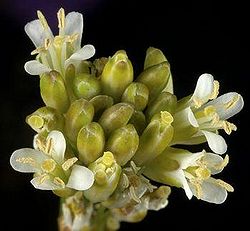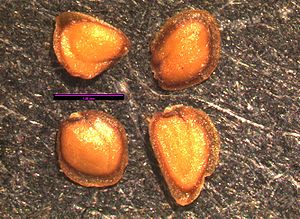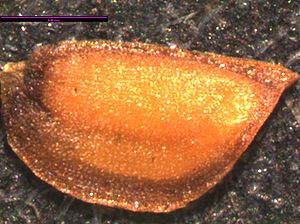Difference between revisions of "Turritis glabra"
| Line 1: | Line 1: | ||
| + | '''Common Name''' Tower mustard | ||
| + | |||
| + | '''Abbreviation Code:''' ARGL | ||
[[File: ARGL_GDCarr_flw_good.jpg|250px|thumb|right|Photographer: G.D. Carr]] | [[File: ARGL_GDCarr_flw_good.jpg|250px|thumb|right|Photographer: G.D. Carr]] | ||
===Taxonomy=== | ===Taxonomy=== | ||
| Line 36: | Line 39: | ||
===Seed=== | ===Seed=== | ||
| − | |||
| − | |||
'''Seed sample from:''' 2011 | '''Seed sample from:''' 2011 | ||
Revision as of 10:19, 11 May 2012
Common Name Tower mustard
Abbreviation Code: ARGL
Contents
Taxonomy
- Kingdom: Plantae
- (unranked): Angiosperms
- (unranked): Eudicots
- (unranked): Rosids
- Order: Brassicales
- Family: Brassicaceae
- Genus: Arabis
- Species: A. glabra
- Binomial name: Arabis glabra (L.) Benth.
- Synonyms: Turritis glabra
Plant Description
Biennial or short-lived perennial from growing from a simple crown, the stem usually single, simple or branched above, 3-15 dm. tall, The plant is pubescent with stiff, simple hairs at the base, becoming glabrous above. Leaves are mainly cauline: the basal ones oblanceolate, 3-14 cm. long, usually remotely toothed, the blade narrowed to a short, winged, greenish petiole. Leaves are pubescent with a mixture of simple and stellate hairs. The Inflorescence is a many-flowered raceme with slender pedicles. Flowers feature 4 sepals, with 4 cream colored petals. Fruits are glabrous, 1-nerved siliques, 6-10 cm. long and 1-1.5 mm. broad.
Bloom Period
March to May or May to July.
Distribution
British Columbia to northern California, east to the Rocky Mountain states.
Habitat
Moist soil in open woods and clearings.
Uses
First Nations
Drunk as an infusion to prevent colds and general sickness when signs first appear.
Seed
Seed sample from: 2011
Average Measurement: 1.3 x 1 x 0.2
Measurement Range: L: 1 - 1.5, W: 0.9 - 1.1, D: 0.1 - 0.3
Features
Shape: Seed narrowly winged with accumbent cotyledons, making the position of the radicle apparent.
Color: Seed wings transparent. Seed brown, darkening towards the hilum.
Surface: Seed coat bumpy and shiny.
Latitudinal Cross Section: elliptical ![]()
Longitudinal Cross Section: elliptical ![]()
Basic Explanations and Assumptions:
The dimensions for the seeds are length x width x depth. The location of the hilum is used as the base of the seed, and the length is measured from hilum to the opposite apex. Where a style is present, the length is measured from the hilum to the bottom of the style. Width is measured at a right angle to the length at the widest part. Depth is measured at a right angle to the intersection of height and width lines.
Measurements included are the mean average for each measurement of ten separate seeds.
All measurements in millimeters unless otherwise noted.



